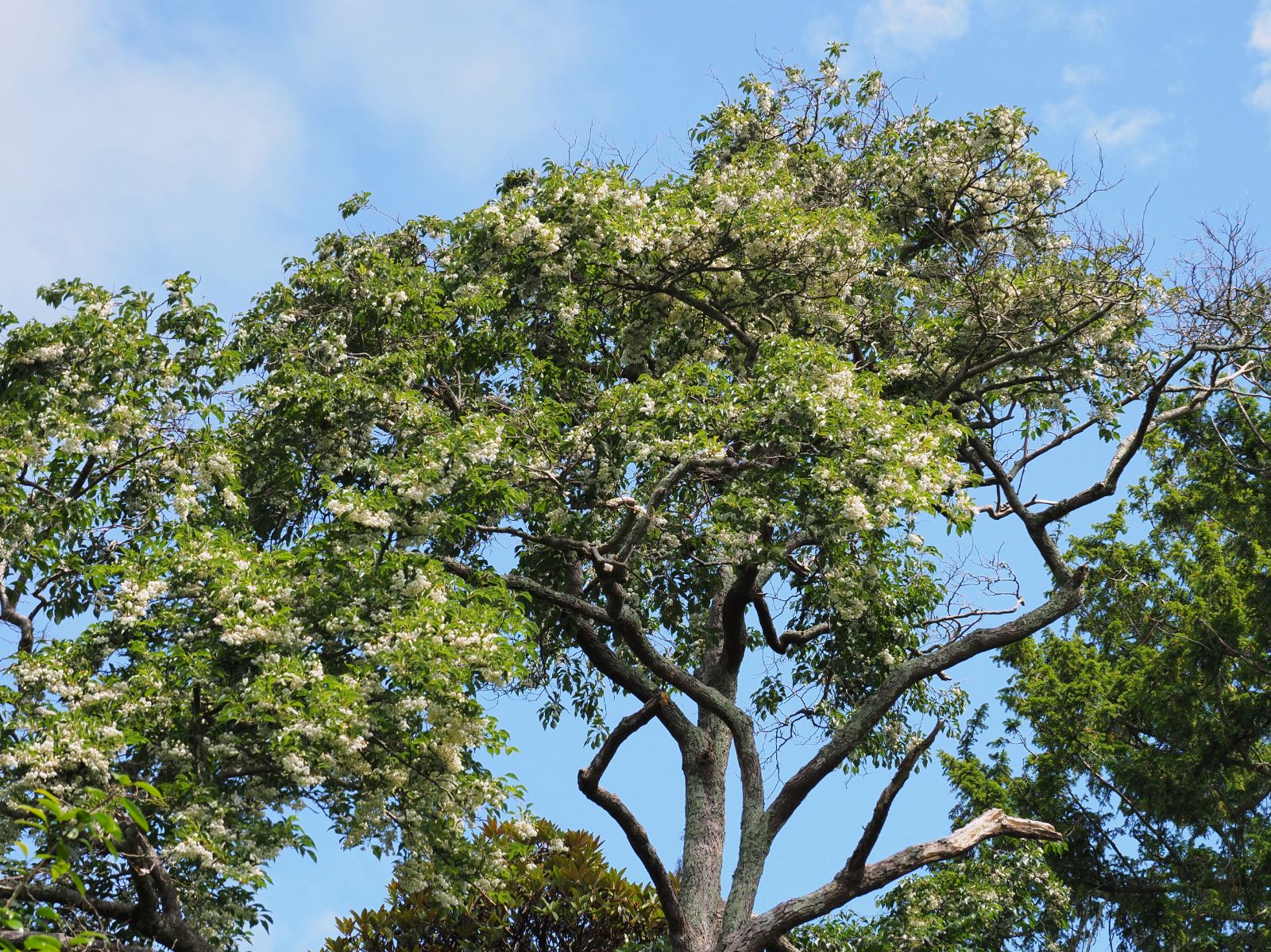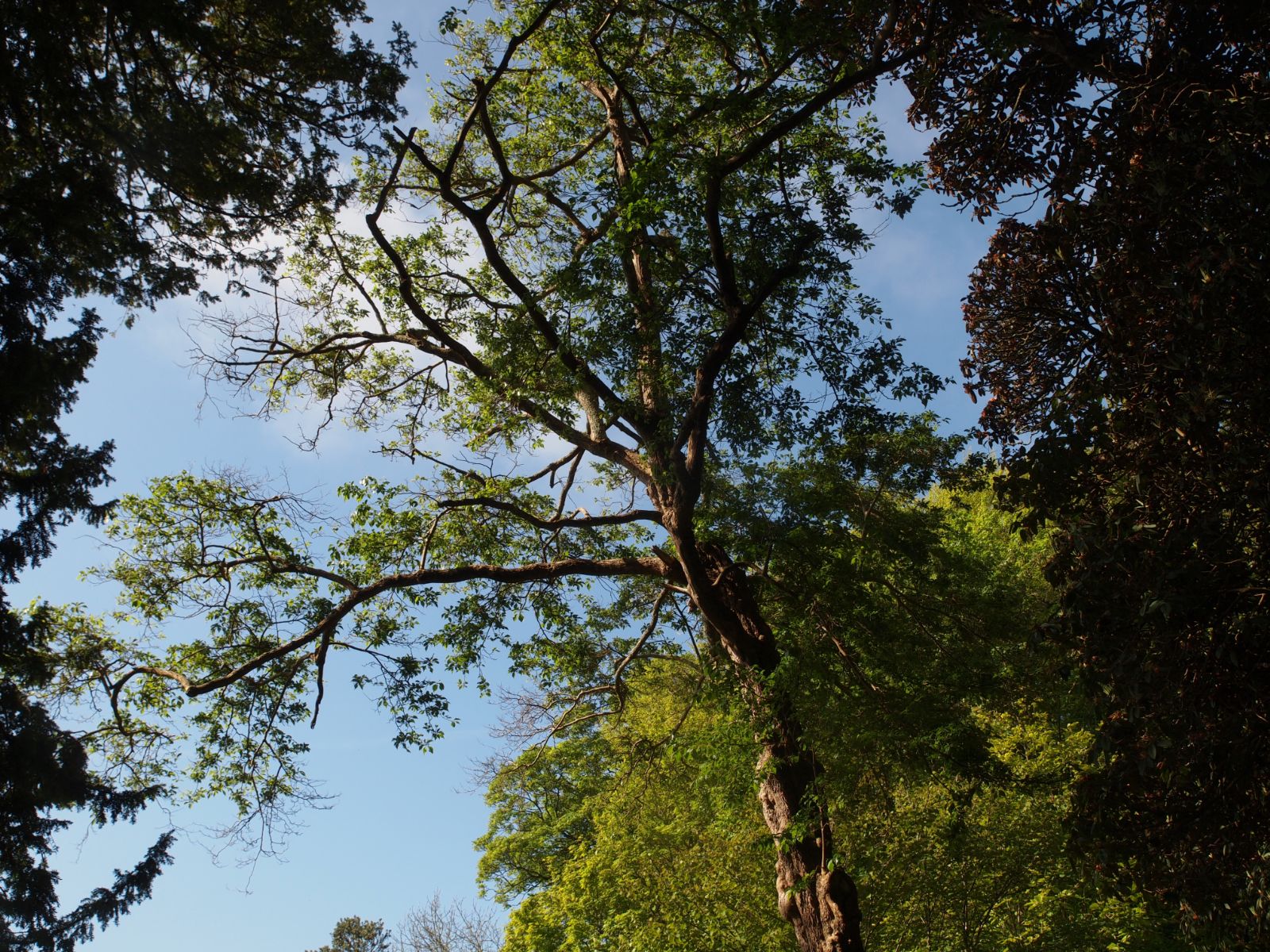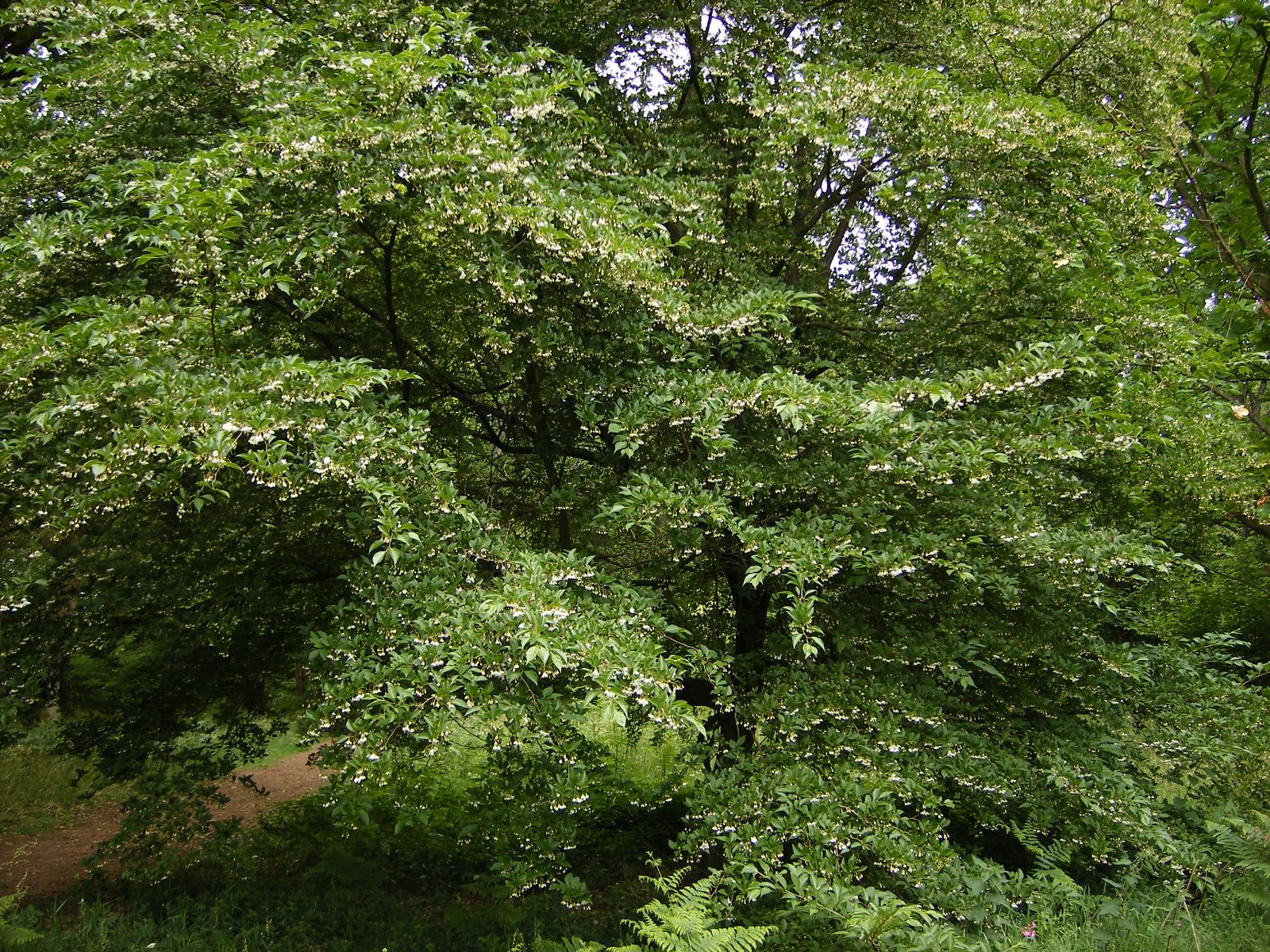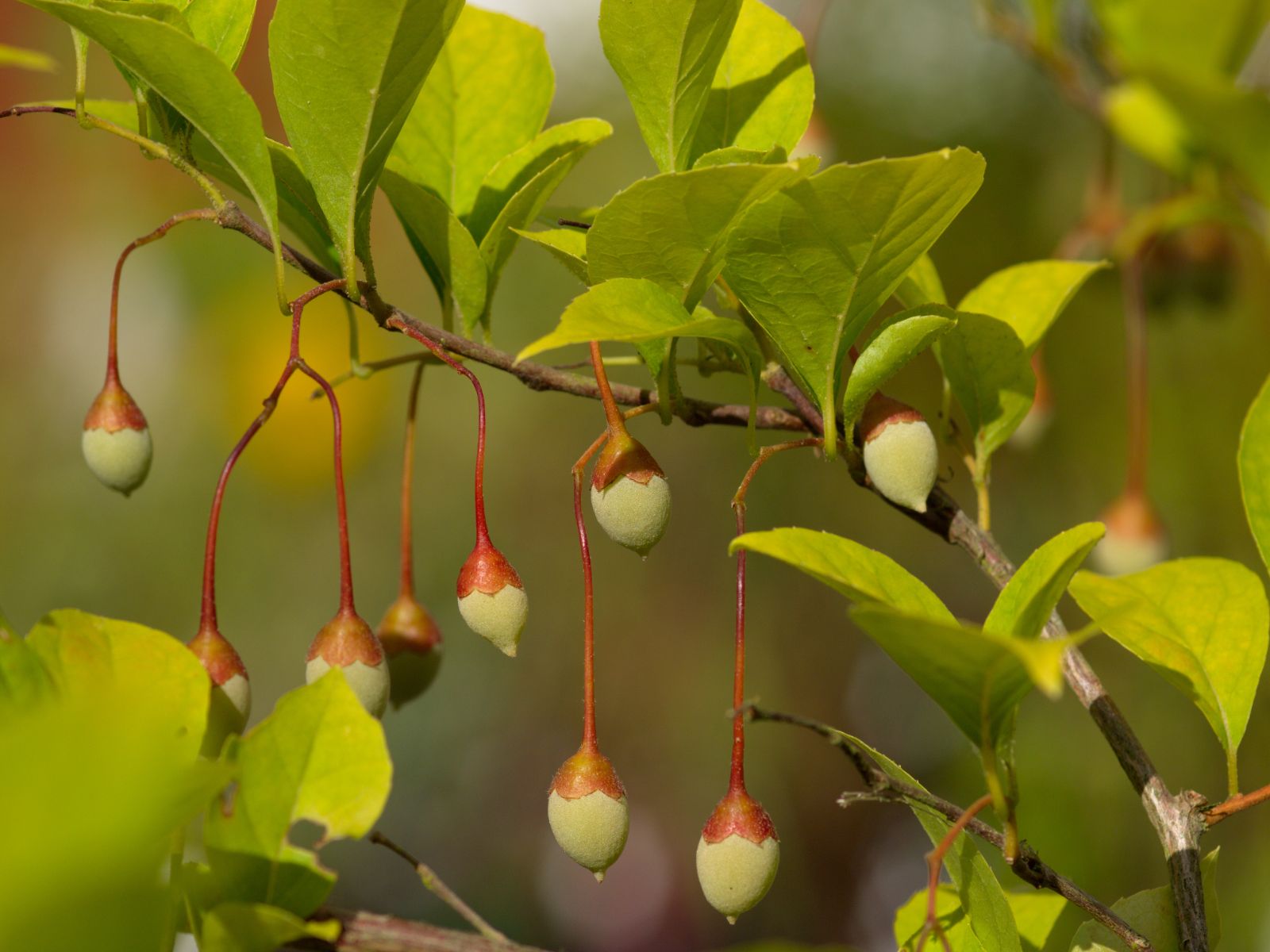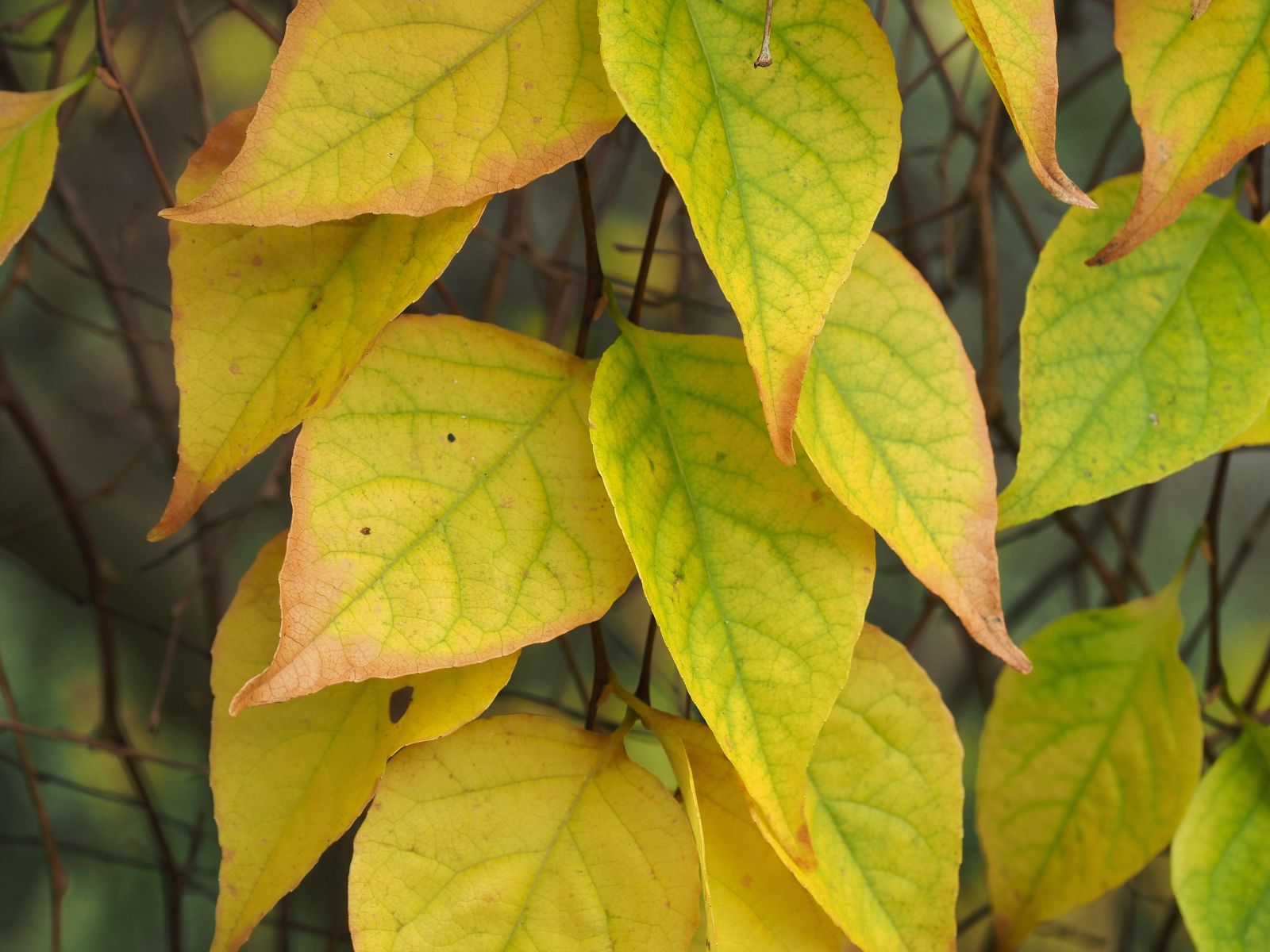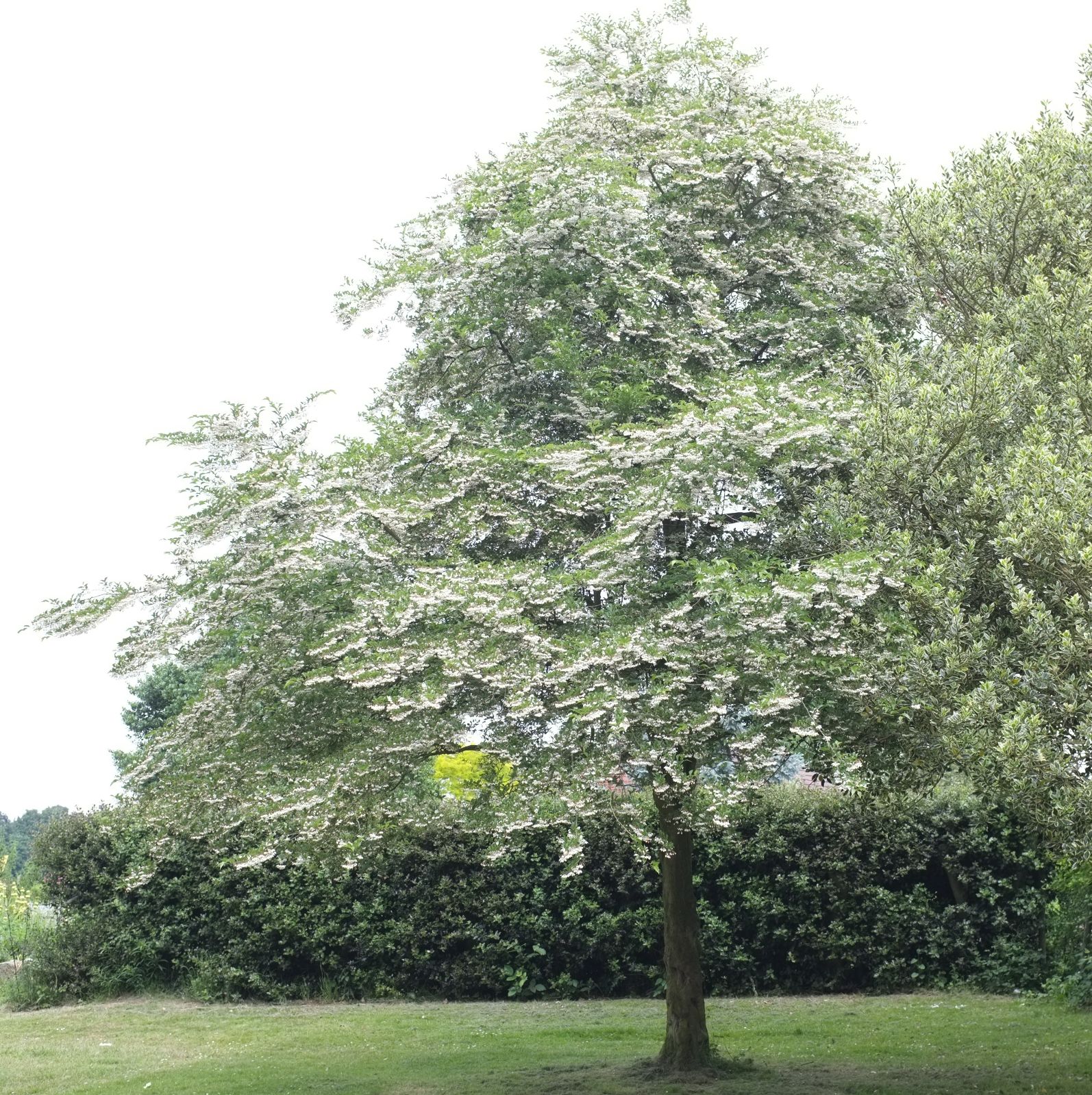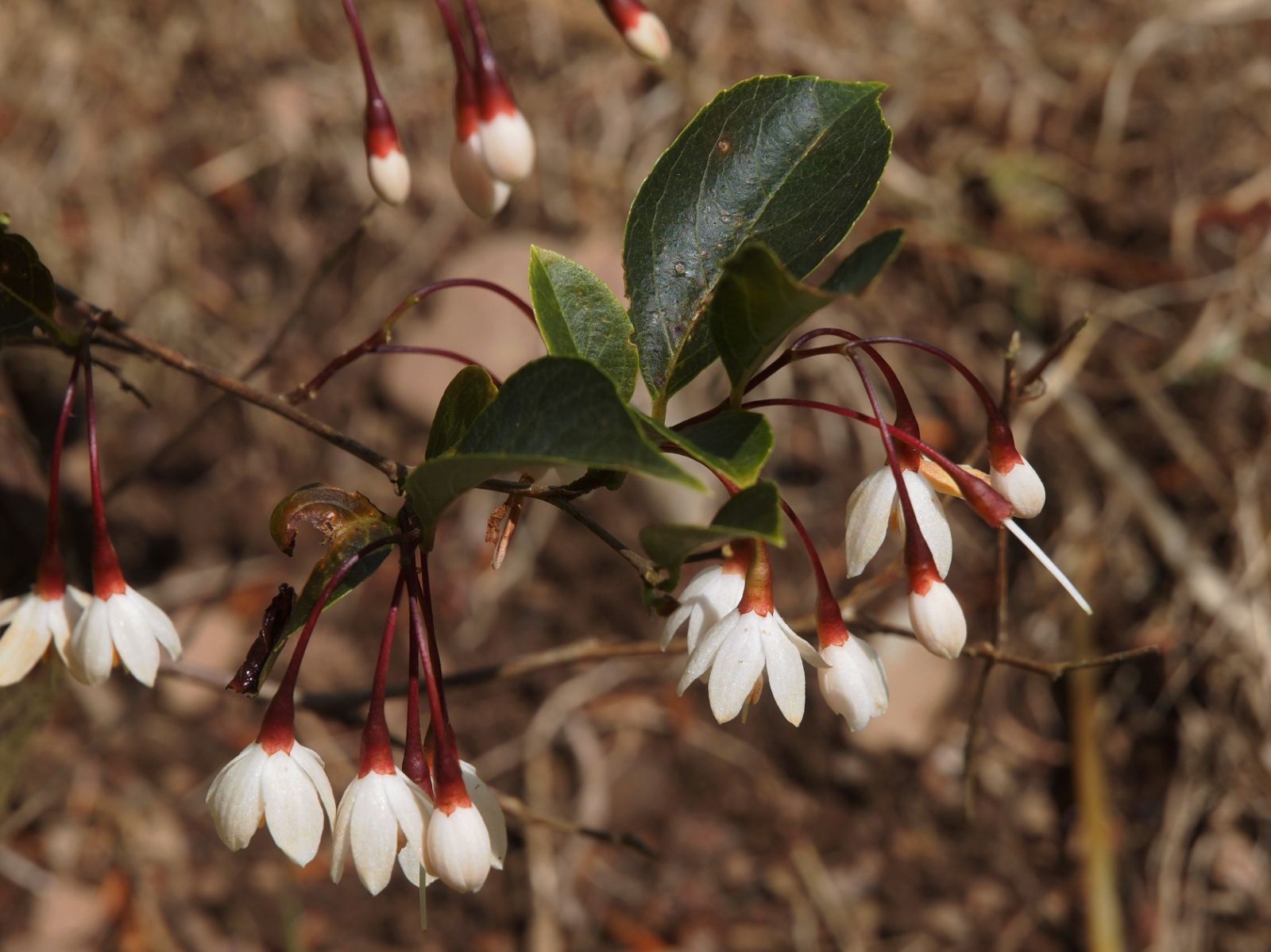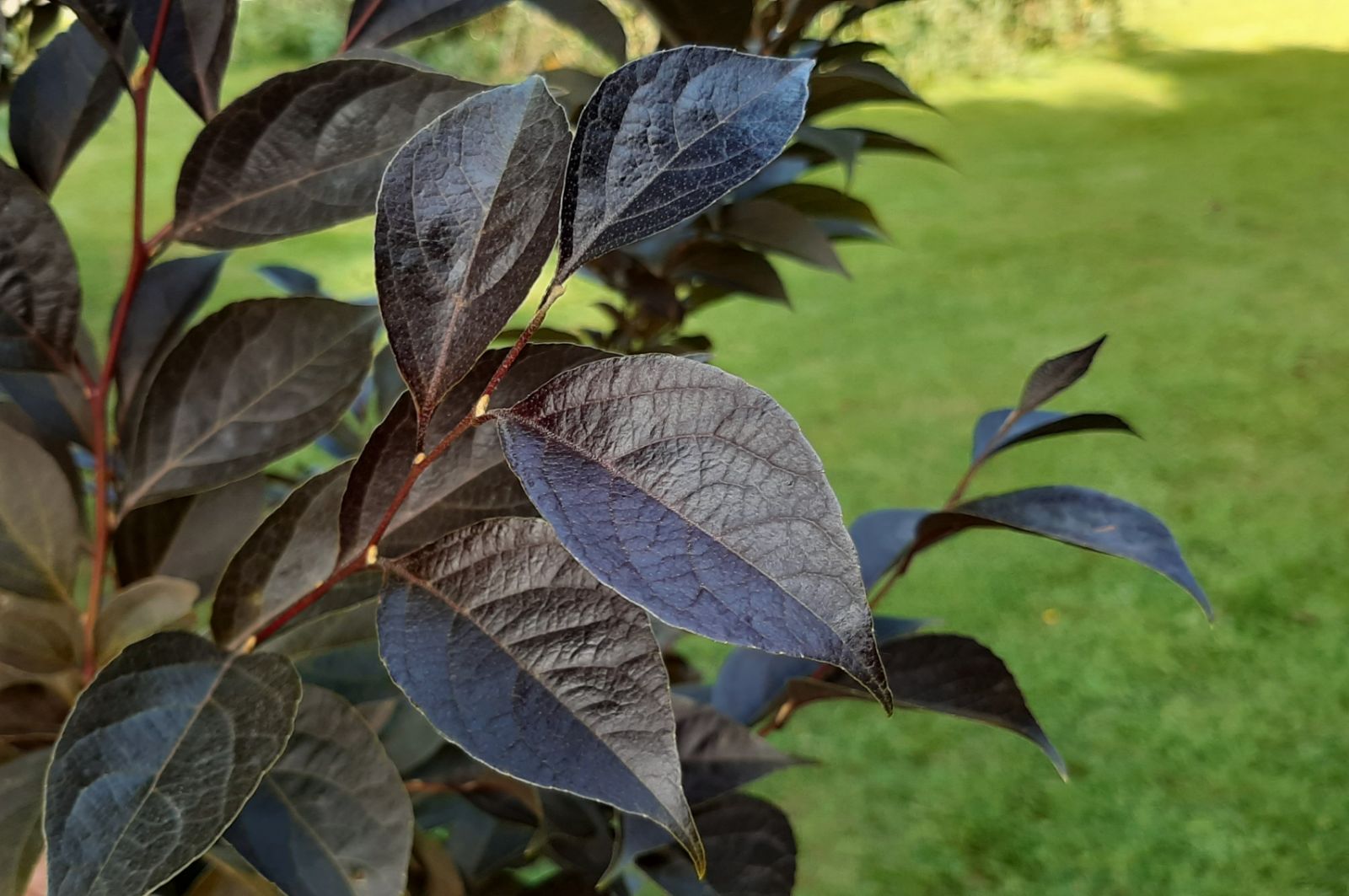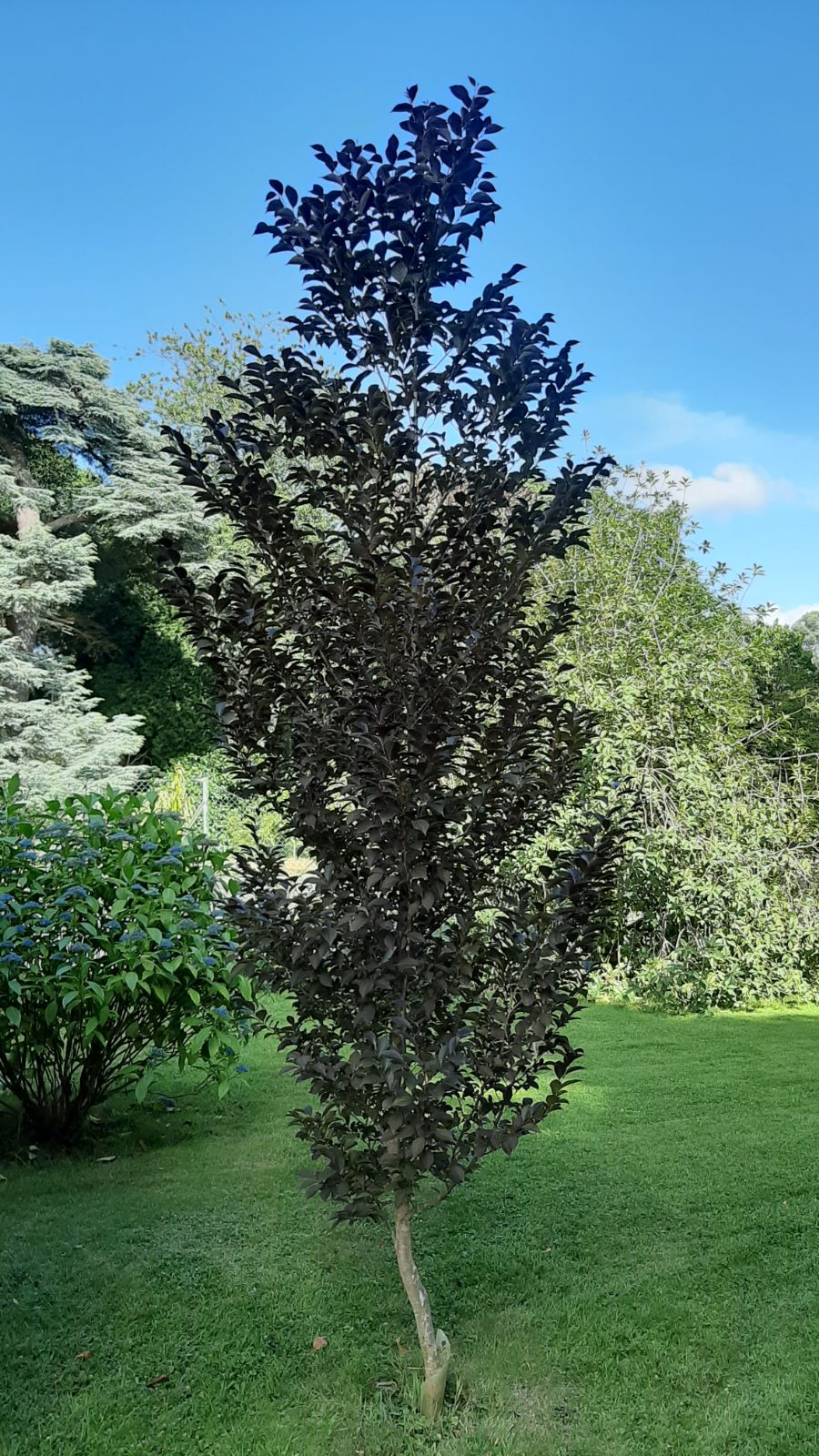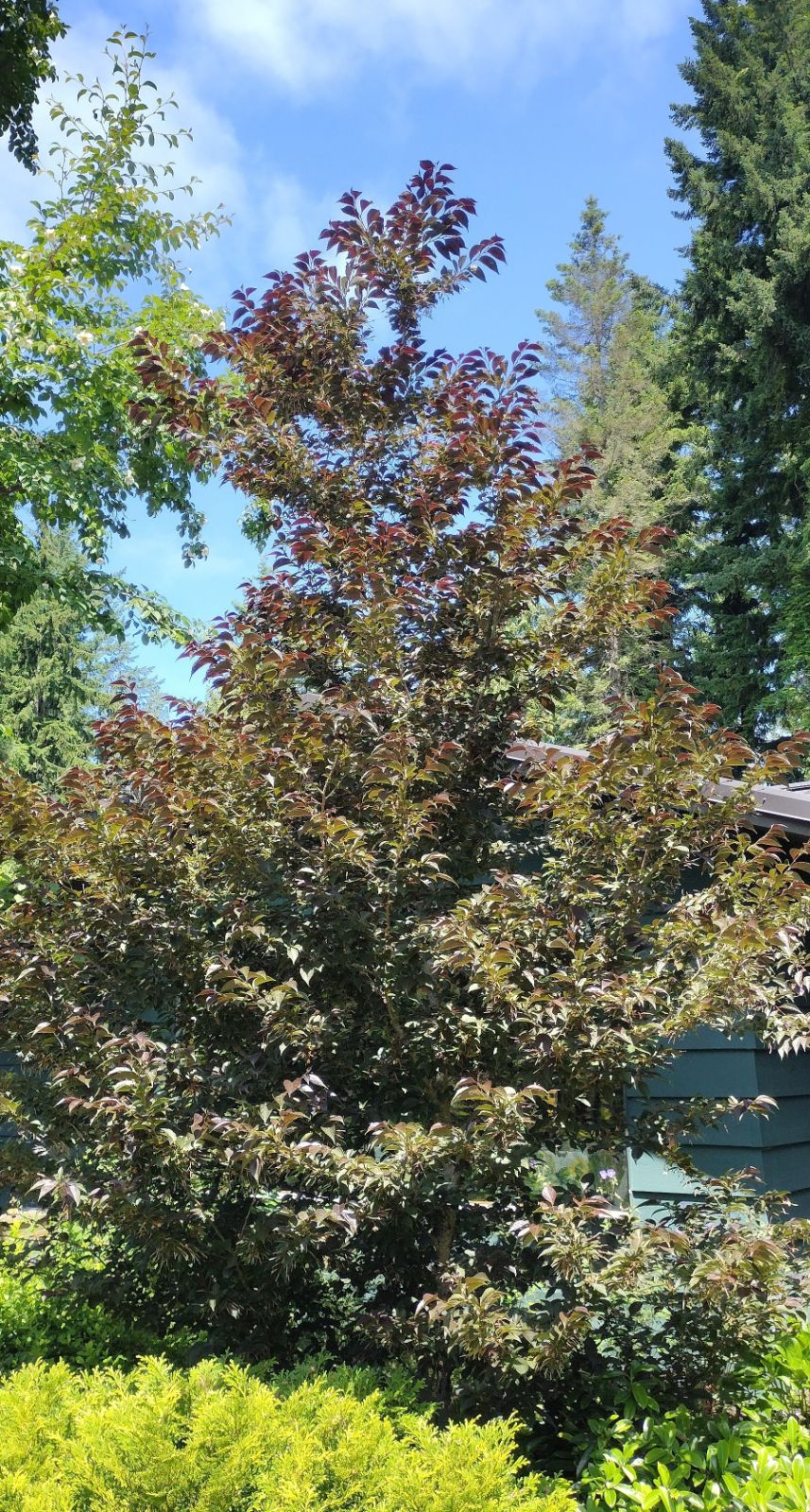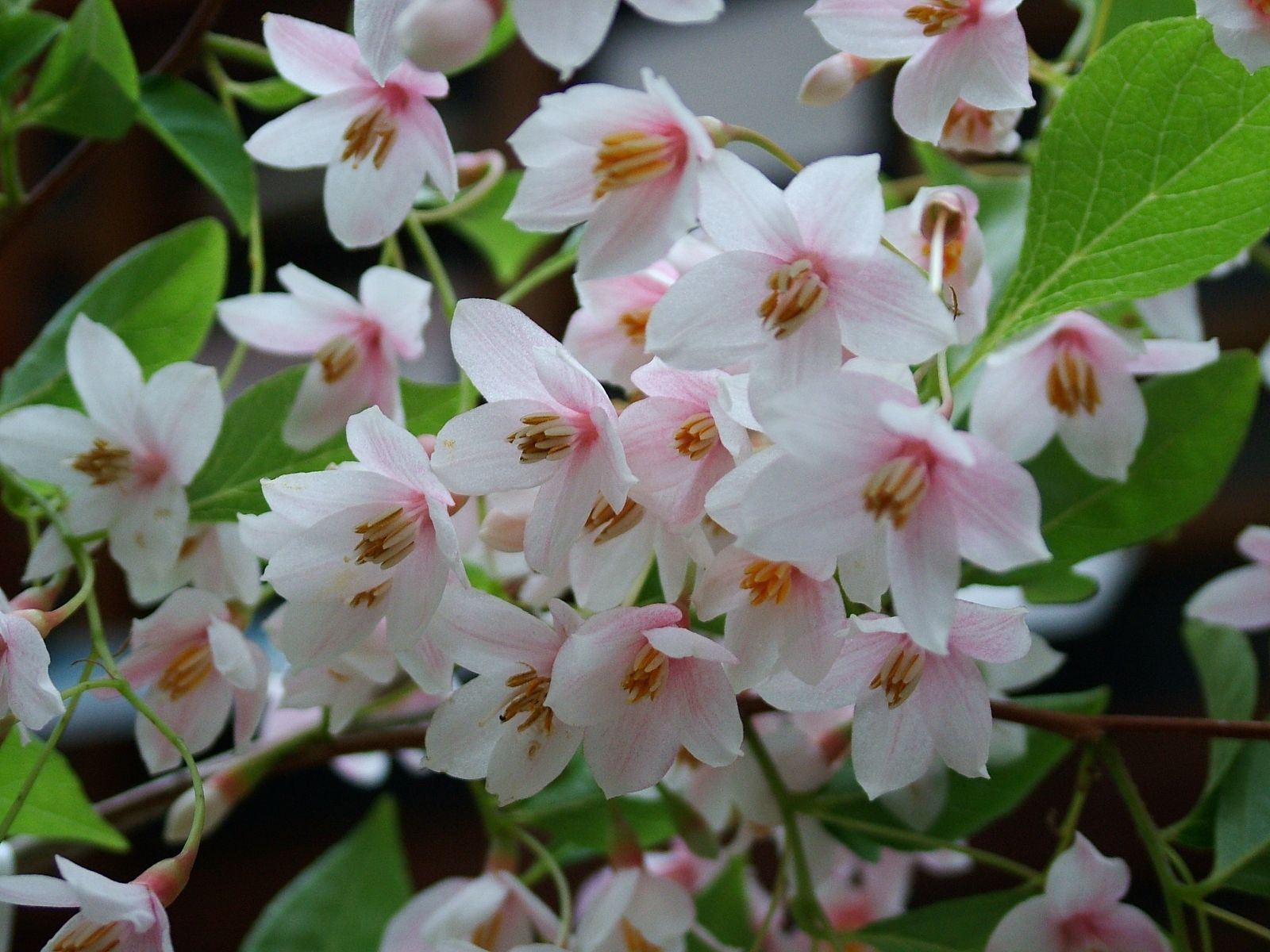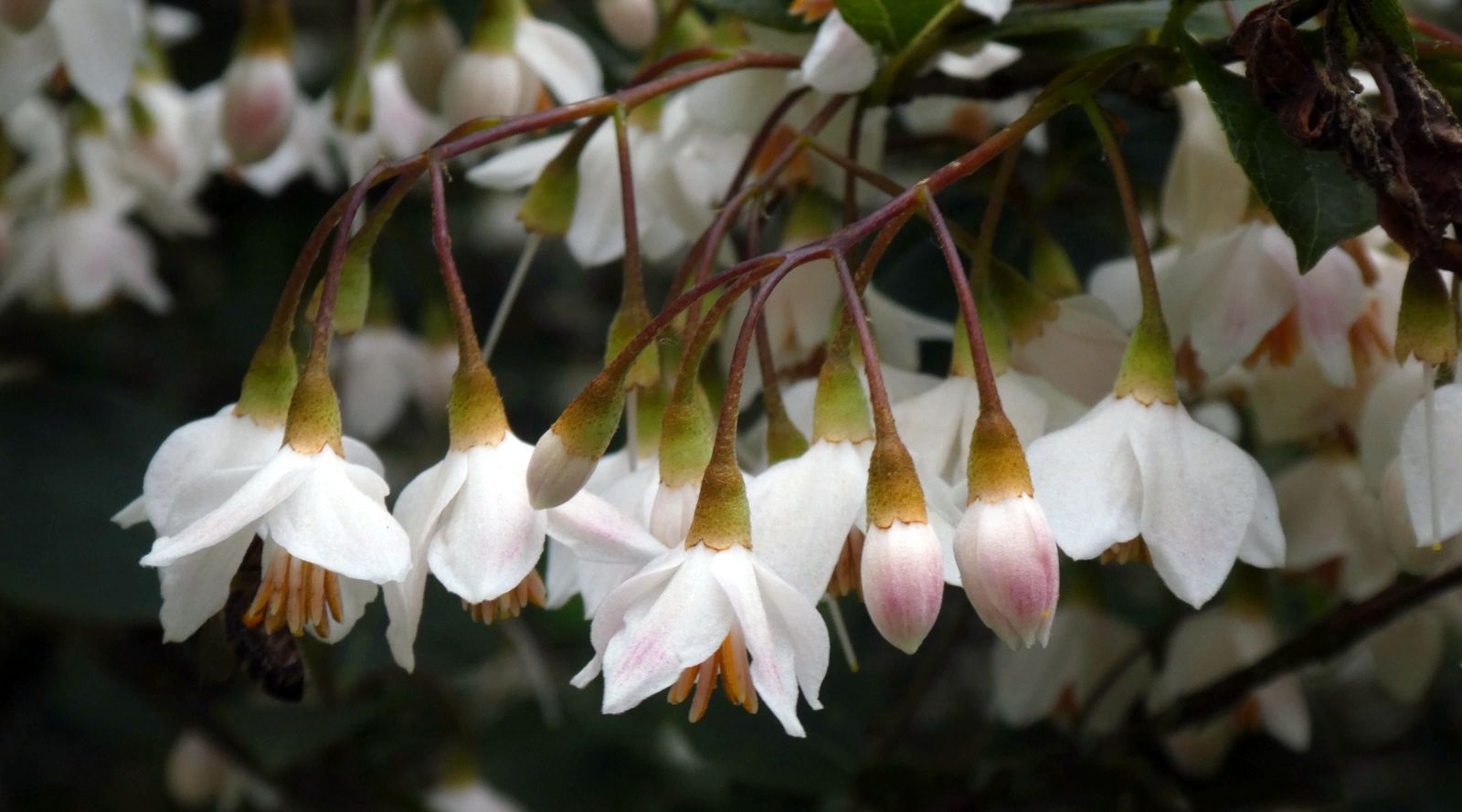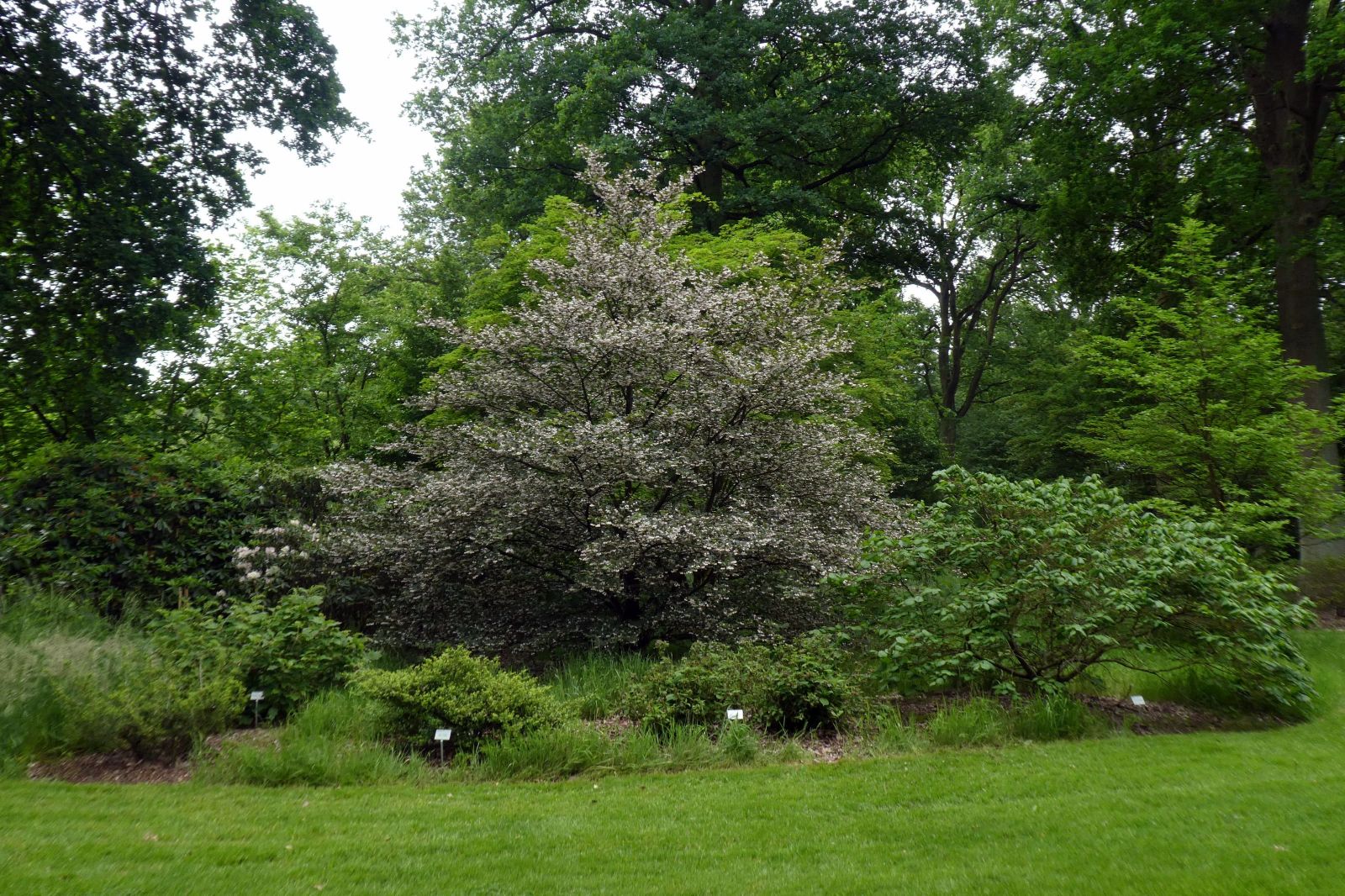Styrax japonicus
Sponsor
Kindly sponsored by
Arabella Lennox-Boyd
Credits
Tom Christian & Alan Elliott (2018)
Recommended citation
Christian, T. & Elliott, A. (2018), 'Styrax japonicus' from the website Trees and Shrubs Online (treesandshrubsonline.
Genus
Common Names
- Japanese Styrax
- Japanese Snowbell
- Japanese Snowbell Tree
Synonyms
- Styrax serrulatum sensu Hook.f. non Roxb.
- Styrax bodinieri H.Lév
- Styrax duclouxii Perkins
- Styrax grandiflorus Griff.
- Styrax kotoensis Hayata
Infraspecifics
Other taxa in genus
- Styrax americanus
- Styrax calvescens
- Styrax confusus
- Styrax dasyanthus
- Styrax faberi
- Styrax formosanus
- Styrax grandifolius
- Styrax hemsleyanus
- Styrax hookeri
- Styrax limprichtii
- Styrax obassia
- Styrax odoratissimus
- Styrax officinalis
- Styrax platanifolius
- Styrax redivivus
- Styrax serrulatus
- Styrax shiraianus
- Styrax suberifolius
- Styrax tonkinensis
- Styrax wilsonii
- Styrax wuyuanensis
Shrubs or small trees, 4–8(–10) m tall. Branchlets purple, slightly flattened, becoming terete. Leaves papery to almost leathery, 3–10 × 2–5(–6) cm, elliptic, oblong-elliptic, or ovate-elliptic, glabrous except for veins or vein axils, five to seven secondary veins on each side of the mid-rib, margin entire or apically remotely serrate, apex acute to shortly acuminate; petiole (0.2–)0.5–1.0 cm. Axillary (pseudo-terminal) racemes, 2–5(–8)-flowered, 5–8 cm long; pedicel 2.5–5 cm, glabrous or sparsely stellate pubescent. Flowers 2–3 cm long; calyx 5-toothed, corolla tube 0.3–0.5 mm; corolla lobes 1.1–2.0 cm long, ovate, oblong-ovate, obovate, or ovate-lanceolate. Stamens shorter than corolla; filaments white villose on free part. Fruit ovoid, 0.8–1.4 cm long, irregularly rugose, dense grey stellate tomentose, apex shortly pointed. (Hwang & Grimes 1996; Ohwi 1965)
Distribution China Anhui, Fujian, Guangdong, Guangxi, Guizhou, Hainan, Hebei, Henan, Hunan, Jiangsu, Jiangxi, Shaanxi, Shandong, Shanxi, Sichuan, Yunnan, Zhejiang Japan North Korea South Korea
Habitat Forest edges, often in secondary forest habitats, 400–1800 m
USDA Hardiness Zone 5-9
RHS Hardiness Rating H5
Styrax japonicus has the largest distribution of any member of the genus and, unlike many other species, is common throughout its extensive range. With such a large natural occurrence it should come as no surprise that it exhibits considerable morphological variation both in the wild and in cultivation, and over the years various authors have named infraspecific taxa, but these are probably best regarded as falling within the natural (if large) variation of the species, variation that is giving rise to an increasing number of named cultivars (Lobdell 2013).
The species was very likely cultivated in the Far East long before its introduction to the West in 1862, when it was introduced to RBG Kew by Richard Oldham from Japanese and Korean provenances, with later collections being made in China by Wilson. Lobdell (2013) suggests it was comparatively poorly known in North America until the early 20th century, and while there is no definitive date of introduction to that continent, it was certainly cultivated at the Arnold Arboretum as early as 1875 from collections made in Japan by a Dr George Hall, with numerous other introductions being made to that institution over the following decades from across the species’ range (Arnold Arboretum 2018), so we may assume that it was at least grown there in specialist collections, if not in the mainstream horticultural trade, from the late 19th century onward.
It is now widely cultivated and may be found in collections and in the horticultural trade throughout the world’s temperate zones. Besides the Arnold Arboretum, Lobdell (2013) found it was reported from a further 78 North American collections, and from 48 in Europe, for example at the University of California Berkeley (University of California Botanical Gardens at Berkeley 2018), at the JC Raulston Arboretum (JC Raulston Arboretum 2018), at Wespelaar in Belgium (Arboretum Wespelaar 2018), at Hørsholm in Denmark (University of Copenhagen 2018), and at the Kórnik arboretum in Poland (K. Nowak pers. comm. 2018). It is cultivated in Australia, for example at Mount Lofty Botanic Garden (The Botanic Gardens of South Australia 2018), and in New Zealand, for example at Eastwoodhill Arboretum (Eastwoodhill Arboretum 2018), where it is also available commercially (pers. obs.).
The species generally makes a short-trunked small tree in cultivation. An established plant in full flower is a beautiful sight, especially if grown in such a position that its full height can be appreciated, such as close to the front of a border or bed, or beside a path in the woodland garden.
The tallest so far recorded in the UK and Ireland is a tree at Embley Park, Hampshire, which was 14 m and 28 cm dbh when measured in 2017, but this might belong to ‘Fargesii’. Other notable examples are at Caerhays, Devon (13 m × 42 cm in 2016), Trewidden, Cornwall (12 m × 43 cm in 2014), Holker Hall, Cumbria (12 m × 46 cm in 2013), Tatton Park, Cheshire (11 m × 32 cm in 2015), Galloway House, Wigtownshire (10 m × 25 cm in 2009), Sheffield Botanical Gardens (9 m × 21 cm in 2015) and the University of Dundee Botanic Garden (8 m × 29 cm in 2017). The largest girthed tree is at Winterbourne Botanic Gardens in Birmingham, and in 2017 was 9 m × 54 cm (The Tree Register 2018).
In recent years various named selections have been made from cultivated material and these cover the usual suite of characteristics for which such clones are selected: structure, flower colour (pink forms) and profusion, dwarfism, variegation and foliage colouration (purple or brown-green), and in one or two instances, perhaps inadvertently, cold hardiness and heat tolerance. The most important cultivars from the dozens that have been named are discussed below. The Benibana Group (occasionally seen as ‘Benibana’) is a Japanese name used to describe any pink-flowered form grown from seed (Lobdell 2013).
As discussed under the pertinent cultivar entries, there are many named selections that are remarkably similar (pendulous forms, pink flowered forms, pendulous and pink flowered forms, etc) and the formal establishment of further groups to cover the plethora of named clones that have been marketed in recent years would be useful. It is likely that some of these names, including perhaps some discussed here, will fall into obscurity in the coming years as they are superseded by improved selections.
'Angyo Dwarf'
As is so often the case in horticulture the term “dwarf” is a little misleading as applied here – “miniature” would be more appropriate. Dirr (2009) says of this clone with lightly frangrant flowers that its ultimate height is 8 – 10 ft (2.4 – 3 m), while Lobdell (2013) refers to a slightly larger specimen growing at the Arnold Arboretum which was 15 ft (4.5 m) tall before 2009.
It was collected by Barry Yinger in Japan in 1978 (presumably from cultivated origin – Angyo is an important centre in Japanese horticulture) and introduced by him to the USA, and hence to the North American horticultural trade by Brookside Gardens (Dirr 2009). It is apparently still confined to cultivation on that continent and in its native Japan: no reference to it growing in European collections could be found at the time of writing in 2018.
Various other dwarf or miniature selections of S. japonicus have been made in recent years, few of which appear to be either particularly different from ‘Angyo Dwarf’ or cultivated outside North America. Indeed, none of the so-called dwarf clones reported by Lobdell (2013) would seem to be anything more than slow-growing, but ultimately typically full-sized if compact, trees. He lists the following names: ‘Camellia Forest Dwarf’ – trialled in the early 1990s and found to be unsatisfactory (eventually growing to a normal size) it is no longer produced; ‘Nana’ – there is scant information available about this clone except to say it was reportedly distributed by the J.C. Raulston arboretum in 1985, it would seem to have since fallen into obscurity; ‘Yatsubusa’ – a dwarf form selected at Moore Farmes Botanic Garden, South Carolina.
Jansen & van Gelderen (2012) report a clone simply called ‘Dwarf’, which as they point out isn’t an acceptable name according to the international code for the nomenclature of cultivated plants. However, this clone, introduced by the Bucholz & Buchholz nursery in Oregon, seems to be more genuinely dwarf than any of the others discussed here. It is described as being a small shrub with dense, ascending growth, which will attain a height and spread of 1 m × 0.6 m in 10 years. It is also said to be particularly hardy, down to –20°C.
The same work discusses another dwarf cultivar named ‘Hyme’ which has intermittently been offered for sale in Europe. Its origins are obscure, justifably prompting speculation that it may simply be synonymous with other similar clones. It is described as a compact plant with small leaves, growing to c. 1 m, very shy to flower when young but coming to flower abundandly and reliably with age (Jansen & van Gelderen, 2012).
'Carillon'
Common Names
Carillon Weeping Japanese Snowbell
Weeping Japanese Snowbell
Synonyms / alternative names
Styrax japonicus 'Carilon'
Styrax japonicus 'Pendula'
Styrax japonicus 'Shidare'
‘Carillon’ is one of several cultivars that have been raised from S. japonicus f. pendulus – an accepted form in its native Japan (for a further discussion around this group, see under ‘Momo-shidare’). The flowers and foliage of this selection do not differ significantly from the type, and forms sold by UK nurseries under the name ‘Pendula’ have white flowers rather than the pink blooms associated with the Momo-shidare group. The branches are pendulous and the overall habit results in large mounded shrub, however the plant can easily be staked to train the leader to a desired height allowing for an attractive, small weeping tree to form. It is reported to have good autumn colour (Jansen & van Gelderen 2012; Lobdell 2013).
This selection was introduced to the US by Barry Yinger from the Shibamichi Nursery in Angyo Japan. The name ‘Carillon’ was select by Yinger & Hahne (1983) to replace the japanese name ‘Shidare’ which simply means weeping; as the Japanese translation of the name given to the botanical form, ‘Shidare’ would have been invalid according to the International Code of Nomenclature for Cultivated Plants (Jansen & van Gelderen 2012).
This culitvar has been widely offered in the US and Japan, and is now becomming more widely grown in Europe. Dirr (2009) says ‘Ryan’s Weeper’ is very similar, although Jansen & van Gelderen (2012) suggest this clone grows only at about one third the rate of ‘Carillon’.
'Crystal'
RHS Hardiness Rating: H5
‘Crystal’ was selected at the J.C. Raulston Arboretum from a batch of seed-raised plants that had been collected on the U.S. National Arboretum Expedition to South Korea in 1985, and introduced to commerce in North America probably in 1992. It is a strong-growing, upright clone, occasionally described as fastigiate. The foliage is described as being a much darker green than the species. The flowers vary in the number of petals they produce, anywhere from 2–9 of pure-white colour, which are set off very well by the dark foliage and the purple flush to both the pedicels and the sepals. Possibly because of the upright habit, some authors consider the flowers of this cultivar to be much more visible and prominent than on other selections where they can be obscured by the foliage. (Dirr 2009, Jansen & van Gelderen 2012, Lobdell 2013).
It is commercially available in both the North American and European horticultural trades, although certainly not widely so in the latter. This seems a pity, as it is an excellent selection combining an upright habit, showy flowers, vigorous growth, and hardiness, which ought to be a most attractive package to horticulturists and landscapers who are seeking to diversify planting schemes, especially in the urban and suburban forest. Another clone which exhibits this strong upright habit is ‘June Snow’.
'Evening Light'
RHS Hardiness Rating: H5
This cultivar was raised in Boskoop, The Netherlands, and named by Henny Kolster who introduced it to commerce in 2013. It has glossy, deep burgundy-coloured leaves which mostly retain their colouration through the growing season, and is described as being a better purple and hardier than the similar ‘Purple Dress’. The flowers are white and lightly scented. A relatively slow-growing selection that will make an attractive vase-shaped tree of only 2.5–3.5 m height in 10 years. The foliage colour is best when grown in full sun. (Jansen & van Gelderen 2012, Lobdell 2013).
'Fargesii'
Common Names
Japanese snowbell 'Fargesii'
Awards
AGM
RHS Hardiness Rating: H5
Styrax japonicus ‘Fargesii’ is generally a more robust, tree-like form of the species, with darker and larger leaves, and pure white flowers borne on purple pedicels two weeks later than the type (Lobdell 2013, Dirr 2009).
Bean explains it was first introduced by Père Farges, probably from northeast Sichuan, who sent seed to the Vilmorin nurseries in France in 1898. From here it was distributed to various collections, including to RBG Kew in 1924, and to Nymans where a tree flowered in 1934. Another plant from the same source, growing in Collingwood Ingram’s garden in Kent, received an RHS Award of Merit when he exhibited it on 29th May, 1945. Bean also conjectures that many of the larger-leaved specimens growing in the UK and Ireland probably belong here, but this supposition was made at a time when the morphological variability of the species across its range was underappreciated. (Bean 1981).
It is well established in the horticultural trade in Europe and North America. A Dutch selection named ‘Farges’s Belle’, raised by Rein and Mark Bulk in Boskoop before 2013, apparently belongs here – no distinguishing characteristics have been reported (Jansen & van Gelderen 2012).
'Fragrant Fountain'
Synonyms / alternative names
Styrax japonicus 'Fragrant Fountains'
Styrax japonicus 'Fragrant Mountains'
This selection, raised and introduced to the trade by Crispin Creations Nursery in Oregon, is described as a relatively compact, tree like form, with a stout trunk and arching branches; more vigorous than ‘Carillion’, like that selection its leaves are a darker green than in the species. As its name suggests this selection is set apart by its sweetly scented flowers, with a perfume stronger than in many other clones (Dirr 2009; Jansen & van Gelderen 2012). It is sometimes sold as ‘Fragrant Fountains’ (as listed by Dirr), ‘Fragrant Mountains’, etc.
Dirr (2009) says it arose as a ‘seedling of ‘Rosea’ [syn. ‘Pink Chimes’ as treated here] possibly pollinated by ‘Carillon”, however both he and Jansen & van Gelderen (2012) suggest that the flowers of ‘Fragrant Fountain’ are white, making no reference to any pink colouration.
'Frosted Emerald'
‘Frosted Emerald’ is another selection from Crispin Creations Nursery in Oregon, USA. This slow-growing clone has irregularly variegated leaves, which might only have cream-white margins when grown in full sun, or which might be almost entirely cream-white with irregular blotches of green usually along the central axis of the leaf blade, but occasionally on the edges too, when grown in the shade. However, it is prone to reversion and the leaves will scorch in intense afternoon sun. It appears not to be cultivated outside North America. (Cubey 2018, Jansen & van Gelderen 2012). Furthermore, it is not apparent that the flowers are particularly noticeable against the variegated foliage.
'Issai'
A fast-growing and floriferous clone, often flowering well even as a young plant, which was introduced to the US from Japan by Barry Yinger in 1982 and made available there via Brookside Gardens, Maryland. Compared with the typical species it is said to have slightly larger leaves, and to flower slightly later, though these characteristics are probably influenced by environmental factors and the rapid growth and free-flowering nature of this cultivar are its most important attributes (Jansen & van Gelderen 2012, Dirr 2009). Its date of introduction to Europe is not known, but it is cultivated here. It was last listed in the RHS Plant Finder in 2014 (Royal Horticultural Society 2018).
'JFS-D'
Synonyms / alternative names
Styrax japonicus SNOWCONE®
RHS Hardiness Rating: H6
USDA Hardiness Zone: 5
A relatively new cultivar raised by J. Frank Schmidt & Son Co. in Oregon, USA (jfschmidt.com). It has quickly found favour among commercial nurseries for its neat, compact, upright habit, which has seen it employed in the urban forest as a street tree. The city of Seattle recommends it as a tree for neighbourhoods and suggests an ultimate height in that climatic zone of c. 7 m (seattle.gov).
'June Snow'
This selection was made by Chris van der Wurff at Heeze, the Netherlands, in 1995 from material of Chinese origin. It is a compact tree with strongly upright growth. In 15 years it can attain 8 m height with a canopy spread of only 2.5 m. It is easily propagated and of rapid growth, and exceptionally hardy, having tolerated winter minimums of –22°C (Jansen & van Gelderen 2012). It will be interesting to see if it maintains its tight upright growth habit with age – if so it may be a most useful clone.
'Kusan'
This selection was introduced to commerce by Bob Tichnor of Oregon State University (now retired) presumably from a cultivated source, but this appears not to be documented. It has a compact, globular form, growing as broad as tall, to 3–4 m in 10 years, and flowering from a young age. A plant labelled as ‘Kisan’ but presumed to mean this clone, growing at the Elisabeth C. Miller Botanical Garden in Seattle was, in 2009, 12 m tall with a canopy spread of 9 m (Lobdell 2013).
'Momo-shidare'
Synonyms / alternative names
'Marley's Pink Parasol'
'J.L. Weeping'
RHS Hardiness Rating: H5
There seems to be a swarm of pink-flowered, pendulous cultivars of S. japonicus that have been selected in Japan, North America, and in Europe, with an associated plethora of names which are, very likely, all variations on a theme. ‘Carillon’ is a pendulous clone but with white rather than pink flowers, and is discussed separately, although it is worth pointing out that the name ‘Carillon’ was selected to replace the Japanese “shidare” which means weeping, and which therefore was illegitimate according to the international code for the nomenclature of cultivated plants.
Similarly, as discussed under the Benibana Group (a group of pink-flowered forms of normal rather than pendulous habit), “beni” is a Japanese word meaning pink, a derivative from the Japanese name of a totally unrelated plant which yields a red dye.
“Momo” however, means “peach”. Quite why this name was applied to a pink-flowered clone is unclear, but this yielded the Japanese name ‘Momo-shidare’, which was imported to the US and, according to Jansen & van Gelderen (2012), has been traded there under the name ‘Marley’s Pink Parasol’. According to the same source a second synonym ‘J.L. Weeping’ was patent-pending in the US in 2012.
Under its various guises, ‘Momo-shidare’ is allegedly distinct from similar clones. For example, ‘Pendulous Pink Chimes’ is described as “similar…but probably less vigorous” (Jansen & van Gelderen 2012) and some authors consider ‘Pink Chimes’ itself to be slightly weeping, for example Hillier & Coombes (2002). A clone selected at the J.C. Raulston Arboretum in North Carolina in about 2002 and named ‘Rubra Pendula’ (another illegitimate cultivar name) is said to be vigorous, with pink flowers and red-brown pedicels and calyces.
'Pink Chimes'
Common Names
Pink-flowered Styrax
Synonyms / alternative names
Styrax japonicus 'Benibana Ego-no-ki'
Styrax japonicus 'Benibana'
Styrax japonicus Benibana Group
Styrax japonicus 'Rosea'
Typical of the species in habit and foliage, the flowers of this selection differ in their pale pink colouration, often shading to darker pink at the base of the petals. Hillier and Coombes (2002) suggest that branches of young plants are lax and nearly pendulous, becoming less so as the plant ages, while Lobdell (2013) describes the overall habit as ‘somewhat upright’ and says the plant is extremely floriferous even when young. Jansen & van Gelderen (2012) partially agree with the Hillier Manual in suggesting that the younger shoots are nodding.
Various pink-flowered, pendulous forms of S. japonicus have been named, including one called ‘Pendulous Pink Chimes’, and there would seem to be confusion around the many variations on a theme (see also the account for ‘Momo-shidare’). ‘Pink Chimes’ sensu stricto was originally selected in Japan (date uncertain) by the Shibamichi Kanjiro Company, Angyo, and named Benibana Ego-no-ki (literally ‘pink-flowered Styrax’). Benibana is the Japanese name for Carthamus tinctorius (Safflower) which yields a red dye when boiled down to remove the yellow pigments and was historically used by Geisha to paint their lips and also to dye expenisive clothing. This form was introduced to the US from the Shibamichi nursery by Barry Yinger in 1977 and the name ‘Pink Chimes’ was selected by Yinger & Hahne (1983) to replace the Japanese name. Yinger & Hahne (1983) believed that as a descriptive prefix to the Japanese name for the species ‘Benibana’ did not meet the rules and recommendations of the International Code of Nomenclature for Cultivated Plants, however the name Benibana has long been used by the Japanese as a catch-all for any pink-flowered form raised from seed, and the collective name Benibana Group is slowly becoming more widely used in North American and European horticulture (Lobdell 2013).
This clone has been cultivated at Boskoop since at least 1982 (Jansen & van Gelderen 2012). Dirr (2009) suggests that ‘Rosea’ should be considered synonymous with ‘Pink Chimes’.
'Pink Snowbell'
Raised in Belgium, this is reportedly similar to ‘Fargesii’ with a broad and upright habit, wide, deeply veined, bronze-green young leaves which turn darker later, and orange autumn colour. It is a floriferous selection, the petals white, flushed pink at the base, the calyx and pedicel purple brown. Growth is said to be more vigorous than that of ‘Pink Chimes’, although from descriptions in literature the pink colouration of that cultivar’s flowers is much stronger. (Jansen & van Gelderen 2012).
'Purple Dress'
Awards
AGM
RHS Hardiness Rating: H5
This variety was awarded an RHS Award of Garden Merit in 2012 and is described as having lustrous reddish-purple foliage when the leaves first emerge, which, although losing their lustre with age, offset the pink-tinged flowers during summer. However, Lobdell (2013) suggests that neither the purple colouration of the foliage nor the pink flush in the flowers is particularly strong, at least when compared with other cultivars selected for these traits growing in the US, and Dirr (2009) gives it only the briefest of mentions. Jansen & van Gelderen (2012), however, suggest it is possibly the best example of coloured leaves in the genus, which combined with the RHS AGM suggest it is well worth growing in Europe.
'Sohuksan'
Common Names
Emerald Pagoda Snowbell
Synonyms / alternative names
Styrax japonicus 'Emerald Pagoda'
RHS Hardiness Rating: H5
This much extolled cultivar was introduced to cultivation in the US by Dr J.C. Raulston, from material he collected in 1985 on Sohuksan island (also known as Gageodo) off the southwest coast of the Korean Peninsula. It distinguishes itself in several ways. Compared with the species the foliage is 2–4 times larger, tougher, darker green, and more lustrous, while the flowers are 2–3 times larger, with thicker petals which vary in number from 2–8 (Lobdell 2013). The flowers are also described as having a sharp lemon scent (Jansen & van Gelderen 2012). The habit has been variously described as upright, distinctly pyramidal, and vase-shaped. In addition to these virtues Dirr suggests it also has greater heat tolerance than many other selections (Dirr 2009), a characteristic that will no doubt become increasingly important in many gardens.
Several US commentators have remarked that it is one of Dr Raulston’s finest introductions, while in the UK it was awarded an RHS Award of Garden Merit in 2012, but ‘Sohuksan’ is a cultivar that almost never was. In a blog post from 2016 David Creech recounts the story as Dr. Raulston told it to him: of a sudden change of heart, a dash back up a mountain, a race to catch a ferry, and a subsequent catalogue of horticultural catastrophes after cuttings had been rushed back to the US by airmail. A single cutting was ultimately the only survivor, and only thanks to some quick-thinking horticulturists who grafted this onto home-grown rootstocks. Without this timely intervention, horticulture would have been denied a truly fine plant. (Creech 2016).
After this chequered introduction to cultivation Raulston finally named his selection for the island where he collected it, although the superflous cultivar name ‘Emerald Pagoda’ appears to be more commonly used in the US, where the selection is more widespread than in Europe. The 2018 RHS Plant Finder lists only four suppliers, but it seems to be gradually becoming more widely planted as it proves its worth in Europe.
'Spring Showers'
This selection was a result of a breeding programme at the US National Arboretum by Dr Sandra Reed. It is described as having a conical habit, very dark green leaves, and being later into leaf than the species and most other cultivars, which may render it useful in areas with late spring frosts. (Lobdell 2013). Dirr (2009) also notes that it is exceptionally heat tolerant.
'Wespelaar'
Synonyms / alternative names
Styrax japonicus 'Herkenrode'
Styrax 'Wespelaar'
This interesting clone was a chance seedling from an open-pollinated plant of S. japonicus ‘Fargesii’ found growing at Arboretum Wespelaar, Belgium. It is widely considered to be of hybrid origin, the second parent generally thought to be S. hemsleyanus, on account of the prominently veined leaves which can turn a dull brown during the summer (Lobdell 2013).
It is described as a broad-crowned tree with purple-brown young shoots, brown buds, and flowers that are pink in bud, fading to white with a pale pink flush, borne in terminal clusters of 5 or 6 on long pedicels. Inspite of its sparse flowering when compared to other clones, the plant distinguishes itself by its large, showy, dark green-brown foliage with prominent venation. If the hybrid origin of the clone is confirmed, then the correct name will become Styrax ‘Wespelaar’. (Jansen & van Gelderen 2012).

